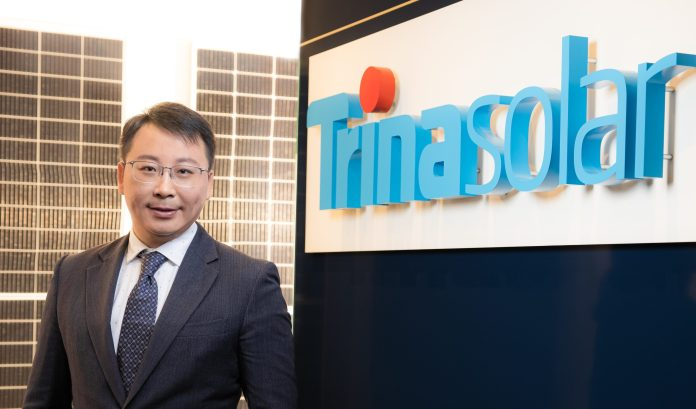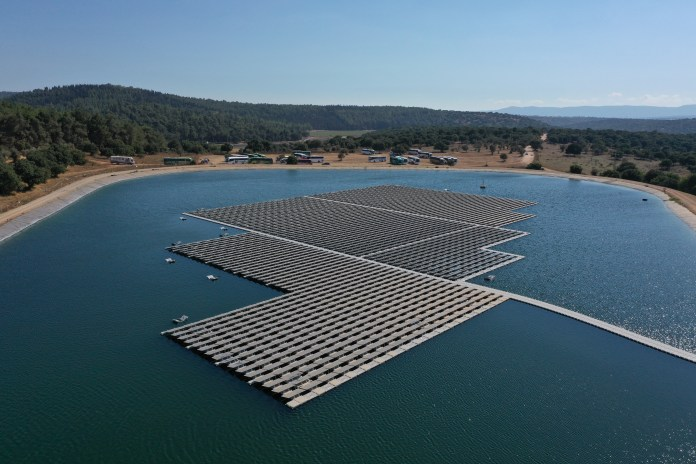An Exclusive Conversation with Todd Li, President of Trina Solar Asia Pacific
- 21/12/27
- Reliability

Todd Li, President, Trina Solar Asia Pacific
How did your journey in the PV industry begin? How has your experience been?
I joined Trina Solar in 2013 as a sales manager for Thailand which is a large and growing market for solar energy. The solar industry is growing in importance around the world because solar helps fight climate change by providing an alternative energy solution that is clean and affordable.
Working in the solar industry is very fulfilling because I know I am working in an industry that is helping the world to fight against climate change by providing an economically viable and sustainable alternative to fossil fuels.
Solar is a fast-growing industry that has provided me with enormous opportunities to develop my career. After working as a sales manager covering Thailand for Trina, I steadily took on new, more senior sales roles with the company before being appointed president of Asia Pacific.
The solar industry is a dynamic one because technology is constantly evolving. I like working for Trina Solar because it is a very technology-driven company. For example, Trina Solar led the commercialization of PERC cell technology and is an industry pioneer of 210mm diameter solar cells.
What were some big developments/undertakings at Trina in 2021?
This year’s biggest industry development was that 210mm diameter solar cells have become the new global industry standard delivering greater power and efficiency.
This change across the solar industry has been underpinned by the 600W+ Photovoltaic Open Innovation Ecological Alliance that was launched last year but continued to gain momentum this year.
The alliance is an innovative ecosystem that – through open collaboration, synergizing the main resources of the industry chain and integrating core processes such as R&D, manufacturing and applications – has resulted in the development of 600W+ ultra-high power modules.
A key objective of the alliance is to see that the whole industry – not just module manufacturers but also manufacturers of inverters, trackers, etc – are developing new products that support 210 solar modules.
In March 2021, we unveiled our new 670W Vertex module, based on 210mm diameter solar cells, that delivers even more power, further underpinning the rapid acceleration of technology in the solar industry.
Modules that use 210mm diameter are a larger format than earlier generation modules but we have pioneered a packaging solution where the modules are packed vertically, instead of horizontally, to maximise the space inside the shipping container when the modules are transported, significantly reducing shipping costs.
We have also been promoting our TrinaTracker product that is compatible with 210 solar modules. One of the things that makes Trina Solar unique is it is the only solar module manufacturer that also designs and manufactures a truly integrated, lowest risk module and tracker solution.
TrinaTracker utilises intelligent machine learning algorithms to reduce shading and boost bifacial performance so that even for sites in SEA that sit close to the equator, the tracker energy advantage over fixed structure is restored to approximately 20% or more. This, in tandem with the fact that trackers make more energy per unit area, mean that trackers deliver the same or better energy at lower DC capacity and, in the same land footprint and AC capacity, reduce the number of modules, steel and BOS that need to be procured, shipped and installed, ultimately reducing overall capex by around 8% and lowering LCOE by more than five percent.
Our company has enormous depth and breadth. We have expanded our manufacturing capacity to meet global demand and was voted by Bloomberg New Energy Finance as bankable by 100% of respondents in its 2021 industry survey. Trina Solar has been ranking top bankable module supplier for 6 consecutive years.

How is Trina Solar facilitating and contributing towards Asia Pacific’s renewable growth?
Countries around the region are turning to solar energy to achieve their renewable energy goals. A key benefit of solar – over other types of renewable energy such as wind and hydro – is it can be more readily deployed. We are facilitating Asia Pacific’s adoption of solar energy by ramping up the production of solar modules to meet growing demand and by developing new modules, namely the 550-670W Vertex modules, that deliver higher power and efficiency so developers can maximise their return on investment and so fewer modules are needed to deliver the same amount of power output. This leads to a lower levelized cost of energy (LCOE) and lower balance of system cost because less cabling, trenching, etc is required. We are encouraging the whole industry to get behind 550-670W modules that incorporate 210mm diameter solar cells and are also promoting the bifacial version of these modules coupled with trackers from TrinaTracker.
What are some upcoming products from Trina Solar that we can look forward to?
Trina Solar is continuing to develop new solar modules that incorporate 210mm diameter solar cells to deliver even higher power and efficiency.
We are just at the beginning of the journey when it comes to realising the potential of this new technology. For example, the larger 210mm diameter wafer 210 technology has great potential when applied to cells that use i-TOPCon or hetero-junction technology (HJT).
At the last SNEC exhibition in Shanghai, we exhibited next-generation i-TOPCon and HJT modules based on 210 technology. The i-TOPCon module possesses a maximum power output of 700W+, with the efficiency of 22.3%. At the expo, Trina Solar also exhibited a HJT module exceeding 710W+ with the efficiency of 22.87%. Both advanced technologies demonstrate the company’s leading position in technology and that modules incorporating the larger wafers is the future technical route.
Besides modules, we are also investing in our TrinaTracker business and are interested in globalising our supply chain with regards to the supply of steel-fabricated structural parts for the tracker from local companies in South East Asia.
What are the quality checks and tests that were done on Trina’s modules that ensure that your modules are the best in the industry?
Our modules are tested for quality assurance by the leading certification and testing authorities in China and around the world. These organisations are independent third-party organisations.
Some of the organisations include: China General Certification Centre; DNV, which is an international organisation headquartered in Norway; Europe’s Certification Entity for Renewable Energies (CERE); UL based in the US; Germany’s TÜV Rheinland; and so on.
In May 2021, PV Evolution Labs (PVEL), one of the leading independent PV test laboratories, released its seventh annual global PV module test results, called the 2021 PV Module Reliability Scorecard Report. Trina Solar was a ‘top performer’ for outstanding product reliability and performance among global PV module manufacturers.
To be a top performer, Trina Solar’s Vertex modules had to go through advanced testing to verify the ultra-high-power modules can maintain outstanding performance even when subject to extreme weather.
Among the line-up of tests, the non-uniform snow-load test simulated uneven pressures caused by a large accumulation of heavy snow on the Trina Solar’s 670W module surface. The highest pressure was applied to the bottom end of the module of up to 7000Pa (equivalent to a depth of 2.8 meters of snow), with the results showing that the power attenuation of the module is only 0.56%.
The extreme low-temperature mechanical load test, a static load testing of positive 5400Pa/ negative 2400Pa under an extremely low -40°C, showed no variation in electroluminescence (EL) and power attenuation of only 0.11%. In the hail test, which simulates the impact of a hail of different sizes on modules, the 210 Vertex 670W module passed the test measuring the impact of hailstones 35 mm in diameter without causing any damage.
In multiple extreme dynamic mechanical load testing, 210 Vertex 670W modules delivered better performance than competitors’ modules with load capacity several times higher than the IEC standard. When installed by clamps, the 210 Vertex 670W double-glass module passed the 20,000 cycles, 20-fold extreme testing, still remaining intact.
In the extreme wind tunnel test, the 210 Vertex 670W module remains intact when the wind speed reached 62m/s (216km/h or 134 mph), passing the extreme wind speed test equivalent to the low end of a Category 4 hurricane on the Saffir-Simpson scale.
Furthermore, TrinaTrackers are verified by the world’s leading wind engineering consultancies RWDI and CPP under full aeroelastic testing, with every small engineering detail rigorously verified, including how the modules are fixed to the structure for long term reliability and maximisation of bifacial boost. TrinaTracker was the first mover to large format modules and our tracker is only one of very few deployed at scale in cyclonic regions, so the decision to partner with the industry’s most bankable brand who offer the industry’s only integrated module/tracker solution ultimately lowers the risk profile much more than conventional disaggregated solutions.
The reason we chose to do these tests of the 670W Vertex modules is not only to empower customers to understand the high reliability of 670W+ modules but also to share research results across the whole of the industry for continuous innovation and comprehensive application of 600W+ modules.
Trina has a very strong focus on R&D. What are the latest research & technological advancements done by the company?
Trina Solar is committed to research and development and continues to set industry standards and benchmarks for performance and sustainability. We have been responsible for a number of global breakthroughs, with 22 world records for PV cell efficiency and solar module power output since 2011. Trina was the first company to receive Client Test Data Program (CTDP) certification from UL, allowing us to conduct cutting-edge research reliably on campus.
With robust and rigorous R&D, Trina Solar’s rapid rate of innovation has led to over 2100 patent applications with 50% of the proportion of invention patents. The company’s cumulative R&D investment has reached US $1.86 billion.
Trina continues to advance efficiency boundaries. Trina Solar State Key Laboratory of PV Science and Technology of China has set a world record in November 2019 of 23.22% with n-type i-TOPCon solar cell on the cast-mono substrate. In June 2021, the Vertex high-efficiency p-type monocrystalline silicon module, based on 66 pieces of 210 mm x 210 mm high-efficiency PERC cells, achieved a record aperture module efficiency of 23.03% for larger-area industrial silicon p-type modules. Through technological innovation, we plan to continue breaking records and driving even higher efficiencies.
(Source: SolarQuarter)
Relevant Topics
Smart Energy Solutions
delivered straight to your inbox


